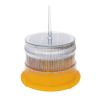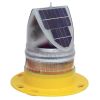Sealite SL-15 1-2NM+ Solar Marine Light
The Sealite SL-15 is a solar marine light that features a 1-2+ nautical mile visible range.
Features
- 16 user programmable flash codes
- Single LED optic
- 3 year fix or replace warranty
- Free ground shipping
- Expedited repair and warranty service
- Lifetime technical support
- More
Overview
The Sealite SL-15 compact LED marine light is an exceptional value and incorporates some of the most advanced technology available. In the tradition of Sealite lanterns, the SL-15 is designed to be maintenance-free with a life expectancy of up to 12 years, with battery replacement approximately every 5 years.
Reactive
The SL-15 can be installed in minutes. Once the flash code is set, no operator intervention is required. The solar module will charge the replaceable battery during daylight hours, and the lantern will automatically begin operation at dusk. The SL15 features the Sealite LED 360 Omni Directional Reflector, which increases the intensity and uniformity of the horizontal output.
Built for Nature
The tough polycarbonate lens is specifically designed for use with LEDs and has an environment-friendly spike deterring unwelcome birdlife. The unit is sealed using an advanced ultrasonic weld, enabling a rugged waterproof seal capable of prolonged and deep immersion (IP68)
- Light Characteristics
- Light Source: 1 LED
- Available Colors: Red, Green, White, Yellow
- Maximum Available Intensity: Red - 6.2cd; Green - 7.6cd; White - 6.8cd; Yellow - 5.9cd
- Visible Range: 1-2+ nautical miles
- Horizontal Output: 360 degrees
- Vertical Divergence: 7 degrees
- Reflector Type: Single LED Optic
- Available Flash Characteristics: 16 user-adjustable IALA flash characteristics
- LED Life Expectancy: >100,000 hours
- Electrical Characteristics
- Current Draw: Refer to Sealite Power Calculator
- Circuit Protection: Integrated
- Nominal Voltage: 3.6
- Autonomy: >50 days (14 hour darkness, 12.5% duty cycle)
- Temperature Range: -40 to 80 C
- Solar Characteristics
- Solar Module Type: Multicrystalline
- Output: 0.45 watts
- Solar Module Efficiency: 14%
- Charging Regulation: Microprocessor controlled
- Power Supply
- Battery Type: High grade NiMH - Environmentally friendly
- Battery Capacity: 1.6Ah
- Battery Voltage: 3.6
- Battery Service Life: Average 5 years
- Physical Characteristics
- Body Material: LEXAN Polycarbonate - UV stabilized
- Lens Material: LEXAN Polycarbonate - UV stabilized
- Lens Diameter: 98mm (3 7/8")
- Lens Design: Single LED Optic
- Mounting: 4x6mm mounting holes
- Height: 141mm (5 1/2")
- Width: 136mm (5 3/8")
- Mass: 0.5kg (1 1/8 lbs)
- Certifications
- CE: EN61000-6-3:1997, EN61000-6-1:1997
- Quality Assurance: ISO9001:2008
- Waterproof: IP68
- Intellectual Property
- Patents: US Pat. No. 6,667,582. AU Pat. No. 778,918
- Trademark: SEALITE is a registered trademark of Sealite Pty Ltd
- Warranty: 3 years
In The News
Wildfire Prevention in the Sierra Nevada Region with the Yuba Watershed Institute
Though recent wildfires have sparked new conversations about wildfire management and response, groups like the Yuba Watershed Institute have been monitoring the forests and water resources of the Sierra Nevada region for decades, managing approximately 5,000 acres of land with the Bureau of Land Management (BLM) and about 7,000 acres in private land partnerships. The goal of the Institute is to work with local communities and land agencies to improve watershed and forestry management through informed practices and public outreach. The goals of the Yuba Watershed Institute are three-fold: Improve the ability of fire suppression agencies like the California Department of Forestry and Fire Protection ( CAL FIRE ) and the US Forest Service.
Read MoreWave Sensors Integration with NexSens Buoys: A Cutting-Edge Solution for Wave Measurment
Real-time wave data supports accurate weather prediction, safe and efficient maritime operations, and provides valuable safety and operating condition information for recreation and commercial fishing. Understanding wave dynamics also helps with the design of protective coastal structures like seawalls, breakwaters, and jetties. It also supports better prediction of their impact on sediment transport and coastal geomorphology. Wave data is a key factor in qualifying and designing offshore wind farms and harnessing kinetic energy for electrical generation. It helps with the understanding of ocean-atmosphere interactions and contributes to studies of sea-level rise and climate change impacts.
Read MoreSpring 2025 Environmental Monitor Available Now
In the Spring 2025 edition of the Environmental Monitor, we highlight partnerships across the world and the importance of collaboration between government agencies, universities, environmental groups, local communities, and other stakeholders. From great white shark research in Cape Cod to monitoring fisheries in Lake Erie, this latest edition underscores partnerships that connect stakeholders in a watershed through environmental data. With an emphasis on data sharing, a combination of real-time and discrete sampling keeps the public and partners informed of environmental conditions. Our writers also sought out science professionals dedicated to working with peers within and outside of the environmental sector.
Read More
















